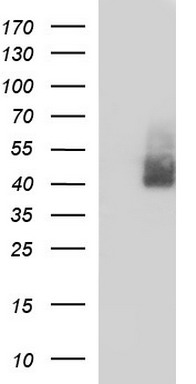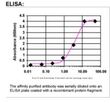Endothelin B Receptor (EDNRB) Rabbit Polyclonal Antibody
Other products for "EDNRB"
Specifications
| Product Data | |
| Applications | ELISA, IF, IHC, WB |
| Recommended Dilution | WB 1:20000, IHC 1:150,ELISA 1:100-1:2000 |
| Reactivities | Human |
| Host | Rabbit |
| Isotype | IgG |
| Clonality | Polyclonal |
| Immunogen | DNA immunization. This antibody is specific for the N Terminus Region of the target protein. |
| Formulation | 20 mM Potassium Phosphate, 150 mM Sodium Chloride, pH 7.0 |
| Concentration | 1.1mg/ml |
| Purification | Purified from mouse ascites fluids or tissue culture supernatant by affinity chromatography (protein A/G) |
| Conjugation | Unconjugated |
| Storage | Store at -20°C as received. |
| Stability | Stable for 12 months from date of receipt. |
| Gene Name | endothelin receptor type B |
| Database Link | |
| Background | The Endothelin Receptor ETB is expressed in most tissues. Mutations of the receptor gene are responsible for Hirschsprung disease type 2, a multigenic disorder with phenotypes such as bicolored irides, megacolon, hypopigmentation, and hearing loss. The ETB receptor has similar affinity for all three endothelins and activates a phosphatidylinositol-calcium second messenger system. A splice variant, termed SVR, has been described; the sequence of the ETB-SVR receptor is identical to ET-B receptor, with the exception of the intracellular C-terminal domain. While both splice variants bind endothelin ET1, they exhibit different responses, which suggests that they may be functionally distinct. The endothelin B receptor has been reported to be expressed in adrenal, aorta, artery, brain, breast, eye, epididymis, ganglion, heart, kidney, liver, lung, ovary, placenta, prostate, skin, testis, uterus, and vessel. ESTs have been isolated from amnion, B-cell/lung/testis, breast, brain, colon, ear, embryo, eye, heart, kidney, liver, liver/spleen, lung, lymph node, placenta, prostate, and skin libraries. |
| Synonyms | ABCDS; ET-B; ET-BR; ETB; ETBR; ETRB; HSCR; HSCR2; WS4A |
| Note | This antibody was generated by SDIX's Genomic Antibody Technology ® (GAT). Learn about GAT |
| Reference Data | |
| Protein Families | Druggable Genome, GPCR, Transmembrane |
| Protein Pathways | Calcium signaling pathway, Melanogenesis, Neuroactive ligand-receptor interaction |
Documents
| Product Manuals |
| FAQs |
{0} Product Review(s)
0 Product Review(s)
Submit review
Be the first one to submit a review
Product Citations
*Delivery time may vary from web posted schedule. Occasional delays may occur due to unforeseen
complexities in the preparation of your product. International customers may expect an additional 1-2 weeks
in shipping.






























































































































































































































































 Germany
Germany
 Japan
Japan
 United Kingdom
United Kingdom
 China
China










